Albrecht Durer

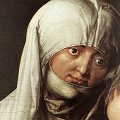 Albrecht Durer, a German painter and printmaker.
Durer is generally regarded as the greatest Northern Renaissance artist. His famous paintings have been the subject of
extensive analysis and interpretation. His watercolours
mark him as one of the first European landscape artists, while his
ambitious woodcuts revolutionized the potential of that medium.
Durer's introduction of classical motifs into Northern art, through
his knowledge of Italian artists and German humanists, have secured
his reputation as one of the most important figures of the Northern
Renaissance. This is reinforced by his theoretical works which involve
principles of mathematics, perspective and ideal proportions. The
quality and wide range of his works and themes, both in terms
of content and formal aspects, are astonishing. Though his paintings
were normally produced as the result of a commission - his two main
areas of focus were portrait painting and the creation of altar pieces
and devotional pictures - Durer enriched them with unusual pictorial
solutions and adapted them to new functions.
After his death, Durer remained one of the most highly regarded of
artists for centuries, representing the process of transition from the
late Middle Ages to the Renaissance in Germany.
Albrecht Durer, a German painter and printmaker.
Durer is generally regarded as the greatest Northern Renaissance artist. His famous paintings have been the subject of
extensive analysis and interpretation. His watercolours
mark him as one of the first European landscape artists, while his
ambitious woodcuts revolutionized the potential of that medium.
Durer's introduction of classical motifs into Northern art, through
his knowledge of Italian artists and German humanists, have secured
his reputation as one of the most important figures of the Northern
Renaissance. This is reinforced by his theoretical works which involve
principles of mathematics, perspective and ideal proportions. The
quality and wide range of his works and themes, both in terms
of content and formal aspects, are astonishing. Though his paintings
were normally produced as the result of a commission - his two main
areas of focus were portrait painting and the creation of altar pieces
and devotional pictures - Durer enriched them with unusual pictorial
solutions and adapted them to new functions.
After his death, Durer remained one of the most highly regarded of
artists for centuries, representing the process of transition from the
late Middle Ages to the Renaissance in Germany.
Portraits by Durer
- Portrait of Barbara Durer (1490)
- Portrait of Albrecht Durer the Elder (1490)
- Self-Portrait at 22 (1493)
- Portrait of Elector Frederick the Wise of Saxony (1496)
- Portrait of Durer's Father at 70 (1497)
- Portrait of a Young Furleger with Her Hair Done Up (1497)
- Portrait of a Young Furleger with Loose Hair (1497)
- Portrait of a Man (1498)
- Self-Portrait at 26 (1498)
- Felicitas Tucher, nee Rieter (1499)
- Hans Tucher (1499)
- Portrait of Elsbeth Tucher (1499)
- Portrait of Oswolt Krel (1499)
- Portrait of St. Sebastian with an Arrow (1499)
- Self-Portrait in a Fur-Collared Robe (1500)
- Portrait of Young Man (1500)
- Portrait of a Young Venetian Woman (1505)
- Portrait of Burkard von Speyer (1506)
- Portrait of a Venetian Woman (1507)
- Portrait of a Young Girl (1507)
- Portrait of a Young Man (1506)
- Emperor Charlemagne (1512)
- Emperor Sigismund (1512)
- Portrait of Michael Wolgemut (1516)
- Portrait of a Cleric (1516)
- Portrait of Emperor Maximilian I (1519)
- Jakob Fugger, the Wealthy (1520)
- Portrait of Bernhard von Reesen (1521)
- Portrait of a Man with Baret and Scroll (1521)
- Portrait of Hieronymus Holzchuher (1526)
- Portrait of Jakob Muffel (1526)
- Alliance Coat of Arms of the Durer and Holper Families (1490)
- Wire-Drawing Mill (1494)
- The Courtyard of the Castle in Innsbruck with Clouds (1494)
- The Courtyard of the Castle in Innsbruck without Clouds (1494)
- Pond in the Woods (1496)
- Young Hare (1502)
- The Large Turf (1503)
Portrait of Barbara Durer (1490)
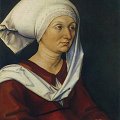 Get
Get  a high-quality picture of
Portrait of Barbara Durer for your computer or notebook. ‣
Shortly before his departure as a journeyman, Durer painted the double
portrait of his parents, his first painted portraits. The portrait of his
mother acted as the counterpart to the portrait of his father, and is
related to the latter in terms of line of sight and body posture. The
portraits are closely matched to each other in terms of composition. The
mother, with a white bonnet, appears as a married woman in a dark red
garment. While the latter is recorded in a summary fashion, her
physiognomy is depicted meticulously. His mother is holding a rosary in her
hand as an expression of her piety, and this gesture is another way in
which she is related to the depiction of his father.
a high-quality picture of
Portrait of Barbara Durer for your computer or notebook. ‣
Shortly before his departure as a journeyman, Durer painted the double
portrait of his parents, his first painted portraits. The portrait of his
mother acted as the counterpart to the portrait of his father, and is
related to the latter in terms of line of sight and body posture. The
portraits are closely matched to each other in terms of composition. The
mother, with a white bonnet, appears as a married woman in a dark red
garment. While the latter is recorded in a summary fashion, her
physiognomy is depicted meticulously. His mother is holding a rosary in her
hand as an expression of her piety, and this gesture is another way in
which she is related to the depiction of his father.
Portrait of Albrecht Durer the Elder (1490)
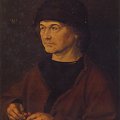 Get
Get  a high-quality picture of
Portrait of Albrecht Durer the Elder for your computer or notebook. ‣
Durer's earliest surviving oil painting, done just after he finished
his apprenticeship, is a portrait of his father, the goldsmith Albrecht the
Elder (1427-1502). Dated 1490, it was painted early in the year, before
Durer left Nuremberg on his journeyman travels in April. Albrecht the
Elder, then probably aged 62 (or 63 if he was born at the beginning of
1427), is depicted from the waist up, wearing a black hat and brown. cape
lined with black fur. He holds a rosary. Durer later wrote that his father
lived an honourable, Christian life, was a man patient of spirit, mild and
peaceable to all, and very thankful towards God'.
a high-quality picture of
Portrait of Albrecht Durer the Elder for your computer or notebook. ‣
Durer's earliest surviving oil painting, done just after he finished
his apprenticeship, is a portrait of his father, the goldsmith Albrecht the
Elder (1427-1502). Dated 1490, it was painted early in the year, before
Durer left Nuremberg on his journeyman travels in April. Albrecht the
Elder, then probably aged 62 (or 63 if he was born at the beginning of
1427), is depicted from the waist up, wearing a black hat and brown. cape
lined with black fur. He holds a rosary. Durer later wrote that his father
lived an honourable, Christian life, was a man patient of spirit, mild and
peaceable to all, and very thankful towards God'.
On the reverse of this portrait are the coats of arms of Albrecht the Elder and those of his wife Barbara Holper. The family name 'Durer' originated from the name of the birthplace of Albrecht the Elder's father, since the village of Ajto where he came from means 'door' in Hungarian and this was translated into German as 'Ture' or 'Dure'. The Durer coat of arms therefore bears an emblematic, open double-door. The portrait of Albrecht the Elder may well have been the right wing of a diptych, with the other panel portraying his wife. A portrait believed to be of Barbara Holper, still in Nuremberg and attributed to Durer, could well be the other half of the diptych, although it may be an early copy of a lost original.
Self-Portrait at 22 (1493)
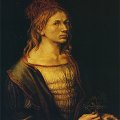 Get
Get  a high-quality picture of
Self-Portrait at 22 for your computer or notebook. ‣
This is Durer's first painted self portrait, dated 1493. It is the
earliest known self portrait in European art produced as an independent
painting (although earlier artists had sometimes portrayed themselves
among figures in an altarpiece or fresco). A sketched self portrait, dated
1493 on the reverse, could well have been an early study for the oil
painting. Durer completed the oil painting towards the end of his travels
as a journeyman, almost certainly in Strasbourg. It was originally on
vellum, which would have made it relatively simple to transport, and this
suggests that it might well have been sent back to Nuremberg.
a high-quality picture of
Self-Portrait at 22 for your computer or notebook. ‣
This is Durer's first painted self portrait, dated 1493. It is the
earliest known self portrait in European art produced as an independent
painting (although earlier artists had sometimes portrayed themselves
among figures in an altarpiece or fresco). A sketched self portrait, dated
1493 on the reverse, could well have been an early study for the oil
painting. Durer completed the oil painting towards the end of his travels
as a journeyman, almost certainly in Strasbourg. It was originally on
vellum, which would have made it relatively simple to transport, and this
suggests that it might well have been sent back to Nuremberg.
Durer inscribed at the top of the self portrait: "Things with me fare as ordained from above", a sign of his faith in God. The artist's youthful features are framed by his lanky, ginger hair, which is topped by a red tasselled cap. Beneath his grey cloak, fringed with red, he wears an elegant pleated shirt with pink ribbons. His strong nose, heart-shaped upper lip and long neck are emphasized in the painting. Using a mirror, Durer obviously found it difficult to paint his hands and eyes, the two features which are always a challenge in a self portrait.
In his rough hands, Durer holds a sprig of sea holly, a thistle-like plant. Its German name means "man's fidelity" and this, together with the fact that the plant was sometimes regarded as an aphrodisiac, has led to speculation that the self portrait was intended as a gift for his fiancie. While Durer was away, his father had arranged for Agnes Frey to become his wife and they eventually married on 7 July 1494, two months after his return to Nuremberg. However, it is just as likely that the self portrait was a gift for his parents, whom he had not seen for nearly four years. One can imagine the surprise and pleasure they must have felt to receive this picture after their son's long absence. It would have been a reminder of his handsome features and further evidence of his blossoming talent.
Portrait of Elector Frederick the Wise of Saxony (1496)
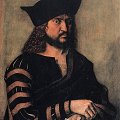 Get
Get  a high-quality picture of
Portrait of Elector Frederick the Wise of Saxony for your computer or notebook. ‣
Frederick III (1463-1525), known as Frederick the Wise, had became
Elector of Saxony in 1486 and was one of the princes entitled to select
the Holy Roman Emperor. He later became Durer's first major patron. This
portrait was probably done when Frederick the Wise visited Nuremberg from
14-18 April 1496. Durer used quick-drying tempera paint, rather than oil
paint, and this may have been so that the picture could be taken away.
Frederick the Wise, then 33, is depicted from the waist up, elegantly
dressed and set against a light-green background. His folded arms rest on
a ledge and in his left hand he holds a small scroll. The monarch's slight
frown is probably intended to convey fortitude. The most striking aspect
of the portrait are Frederick's piercing eyes, staring straight at the
viewer.
a high-quality picture of
Portrait of Elector Frederick the Wise of Saxony for your computer or notebook. ‣
Frederick III (1463-1525), known as Frederick the Wise, had became
Elector of Saxony in 1486 and was one of the princes entitled to select
the Holy Roman Emperor. He later became Durer's first major patron. This
portrait was probably done when Frederick the Wise visited Nuremberg from
14-18 April 1496. Durer used quick-drying tempera paint, rather than oil
paint, and this may have been so that the picture could be taken away.
Frederick the Wise, then 33, is depicted from the waist up, elegantly
dressed and set against a light-green background. His folded arms rest on
a ledge and in his left hand he holds a small scroll. The monarch's slight
frown is probably intended to convey fortitude. The most striking aspect
of the portrait are Frederick's piercing eyes, staring straight at the
viewer.
Frederick the Wise must have been pleased with this portrait as Durer was then commissioned to paint a series of important altarpieces for the church at the Elector's palace in Wittenberg. Durer sketched Frederick the Wise 27 years later as an elderly statesman and the following year the drawing was used for an engraving.
Portrait of Durer's Father at 70 (1497)
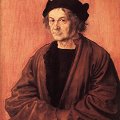 Get
Get  a high-quality picture of
Portrait of Durer's Father at 70 for your computer or notebook. ‣
The portrait is inscribed '1497 Albrecht Durer the Elder at age 70'.
Durer's father appears considerably older than in the portrait of seven
years earlier. His lips are thinner, his face more heavily lined with
wrinkles and his narrow eyes have a wearier appearance. Yet Albrecht the
Elder has retained his wisdom and dignity. After his death, Durer wrote
that his father passed his life in great toil and stern, hard labour... He
underwent manifold afflictions, trials and adversities.' Albrecht the
Elder died five years after this portrait was painted, at the age of 75.
a high-quality picture of
Portrait of Durer's Father at 70 for your computer or notebook. ‣
The portrait is inscribed '1497 Albrecht Durer the Elder at age 70'.
Durer's father appears considerably older than in the portrait of seven
years earlier. His lips are thinner, his face more heavily lined with
wrinkles and his narrow eyes have a wearier appearance. Yet Albrecht the
Elder has retained his wisdom and dignity. After his death, Durer wrote
that his father passed his life in great toil and stern, hard labour... He
underwent manifold afflictions, trials and adversities.' Albrecht the
Elder died five years after this portrait was painted, at the age of 75.
The condition of this painting is poor, particularly in the background and the cloak, and in the past many scholars believed that it was a copy of a lost original. However, since it was cleaned in 1955, there has been more support for the view that this is indeed the original. Fortunately the face is the part of the picture which remains in the best condition.
This portrait may originally have been displayed with Durer's self-portrait of the following year, either hung in the same room in the family home or even linked as a diptych. Although Durer and his father are wearing very different clothing and the backgrounds do not match, the two portraits are almost the same size and the half length poses are similar. The pictures were apparently kept together as a pair, since they were presented by the city of Nuremberg to the Earl of Arundel in 1636 as a gift for Charles I of England. Both paintings were sold in 1650 by Cromwell. The portrait of Albrecht Durer the Elder stayed in Britain and was eventually bought by the National Gallery in 1904.
Portrait of a Young Furleger with Her Hair Done Up (1497)
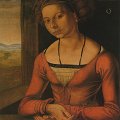 Get
Get  a high-quality picture of
Portrait of a Young Furleger with Her Hair Done Up for your computer or notebook. ‣
This portrait, together with the Portrait of a Young Furleger with
Loose Hai, forms part of a diptych. When the portraits were still together,
they passed on from Carl von Waagen to other owners, until it alone was
finally acquired by the museums of Berlin in 1977. The various
restorations have partially or entirely destroyed areas of the landscape
and the inscription on the card at the top; the same holds true for the
small statue of the prophet, inserted in the window post, which, from the
side, looked toward the other portrait and in whose book Durer had written
his monogram, as Wenzel Hollar's engraving shows. At one time, the two
portraits were considered to be two representations of the same person,
namely, Katharina Furleger. The series of letters on the trim of the
blouse also seemed to point to this; however, they are probably the
initials of a motto. Today, it is generally believed that they are
portraits of two younger sisters of the Furleger family. The portrait,
along with its companion-piece, acts as part of a fairly uncommon diptych;
it is the representation of the two Furleger sisters of Nuremberg.
a high-quality picture of
Portrait of a Young Furleger with Her Hair Done Up for your computer or notebook. ‣
This portrait, together with the Portrait of a Young Furleger with
Loose Hai, forms part of a diptych. When the portraits were still together,
they passed on from Carl von Waagen to other owners, until it alone was
finally acquired by the museums of Berlin in 1977. The various
restorations have partially or entirely destroyed areas of the landscape
and the inscription on the card at the top; the same holds true for the
small statue of the prophet, inserted in the window post, which, from the
side, looked toward the other portrait and in whose book Durer had written
his monogram, as Wenzel Hollar's engraving shows. At one time, the two
portraits were considered to be two representations of the same person,
namely, Katharina Furleger. The series of letters on the trim of the
blouse also seemed to point to this; however, they are probably the
initials of a motto. Today, it is generally believed that they are
portraits of two younger sisters of the Furleger family. The portrait,
along with its companion-piece, acts as part of a fairly uncommon diptych;
it is the representation of the two Furleger sisters of Nuremberg.
In contrast to the other young woman, depicted with loose hair, this one - an eighteen-year-old, according to the inscription - wears her hair in large braids wrapped around her head, a sign that she opted for marriage. Her defiant gaze is also proof of this. Similarly allude the sprigs of sea holly (Eryngium campestre) and Southernwood (Artemisia abrotanum), symbols of conjugal fidelity and eroticism, which she holds in her hand. Note that one of the portraits has a neutral background, while the other has a window with a landscape scene. One interpretation could be that one of the young women renounces the world, while the other welcomes it openly. In both figures, Durer reveals pathologic symptoms: the young woman with the loose hair has goiter, and the two of them show signs of arthritis in their hands.
Portrait of a Young Furleger with Loose Hair (1497)
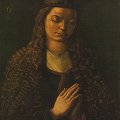 Get
Get  a high-quality picture of
Portrait of a Young Furleger with Loose Hair for your computer or notebook. ‣
This portrait, together with the Portrait of a Young Furleger with Her
Hair Done Up, forms part of a rather uncommon diptych. The coats of arms,
added shortly after and placed on the external side beside the portraits,
were those of the same family, even though the coats of arms are
different: one has a cross between two fish, the other an upside-down
lily.
a high-quality picture of
Portrait of a Young Furleger with Loose Hair for your computer or notebook. ‣
This portrait, together with the Portrait of a Young Furleger with Her
Hair Done Up, forms part of a rather uncommon diptych. The coats of arms,
added shortly after and placed on the external side beside the portraits,
were those of the same family, even though the coats of arms are
different: one has a cross between two fish, the other an upside-down
lily.
The emperor Sigismund had authorized the families of ecclesiastic members to add a cross to their own coats of arms. For this reason, it was deduced that the young woman portrayed with loose hair, the coral bracelet, the hands joined in prayer, and her head bowed down had devoted herself to the cloistered life. The Latin inscription added to the engraving Wenzel Hollar modeled on this painting, also recommended following in the path of Christ.
The very fine brushstrokes of this exquisite painting and the sharp distinction between the areas in light and those in shadow give the face a sense of plasticity, endowing it with a particularly vivid expression. Scholars demonstrated that the two portraits truly formed a pair and that they were acquired together in 1636 in Nuremberg by the count of Arundel, whose engraver, Wenzel Hollar, made two engravings modeled from them. It should be noted that the young woman with the loose hair also rests her arms on a window sill.
In 1673, the portraits were acquired, together as always, by the bishop of Olmutz, from whom they later went on to Carl von Waagen, of Munich. Afterward, the two portraits were separated.
Portrait of a Man (1498)
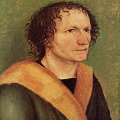 Get
Get  a high-quality picture of
Portrait of a Man for your computer or notebook. ‣
The contrast between the internal strength that emanates from his face,
and the wisdom and foresight in his eyes, on the one hand - and the messy
and wild hair, on the other, effectively demonstrates the breadth of
Durer's skills as a painter, even if the completely distorted perspective
of the left shoulder remains inexplicable.
a high-quality picture of
Portrait of a Man for your computer or notebook. ‣
The contrast between the internal strength that emanates from his face,
and the wisdom and foresight in his eyes, on the one hand - and the messy
and wild hair, on the other, effectively demonstrates the breadth of
Durer's skills as a painter, even if the completely distorted perspective
of the left shoulder remains inexplicable.
Heinz Kisters acquired this painting in 1952 from the antique market in London. The state of preservation, following the removal of one layer of a painting that had been painted over it, appears relatively good. The painting has been included among the Durer's original works.
Self-Portrait at 26 (1498)
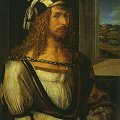 Get
Get  a high-quality picture of
Self-Portrait at 26 for your computer or notebook. ‣
This self portrait is dated 1498 and inscribed: "I have thus painted
myself. I was 26 years old. Albrecht Durer." Since the artist turned 27 on
the 21 May, the picture must date from the beginning of the year. The
artist's pose is self confident, showing him standing upright and turning
slightly to lean his right arm on a ledge. Durer's figure fills the
picture, with his hat almost touching the top. His face and neck glow from
the light streaming into the room and his long curly hair is painstakingly
depicted. Unlike his earlier self portrait, he now has a proper beard,
which was then unusual among young men. Nine years later Durer wrote an
ironic poem in which he described himself as 'the painter with the hairy
beard'.
a high-quality picture of
Self-Portrait at 26 for your computer or notebook. ‣
This self portrait is dated 1498 and inscribed: "I have thus painted
myself. I was 26 years old. Albrecht Durer." Since the artist turned 27 on
the 21 May, the picture must date from the beginning of the year. The
artist's pose is self confident, showing him standing upright and turning
slightly to lean his right arm on a ledge. Durer's figure fills the
picture, with his hat almost touching the top. His face and neck glow from
the light streaming into the room and his long curly hair is painstakingly
depicted. Unlike his earlier self portrait, he now has a proper beard,
which was then unusual among young men. Nine years later Durer wrote an
ironic poem in which he described himself as 'the painter with the hairy
beard'.
The artist's clothing is flamboyant. His elegant jacket is edged with black and beneath this he wears a white, pleated shirt, embroidered along the neckline. His jaunty hat is striped, to match the jacket. Over his left shoulder hangs a light-brown cloak, tied around his neck with a twisted cord. He wears fine kid gloves.
Inside the room is a tall archway, partly framing Durer's head, and to the right a window opens out onto an exquisite landscape. Green fields give way to a tree-ringed lake and beyond are snow-capped mountains, probably a reminder of Durer's journey over the Alps three years earlier. Depicting a distant landscape, viewed through a window, was a device borrowed from Netherlandish portraiture.
The Germans still tended to consider the artist as a craftsman, as had been the conventional view during the Middle Ages. This was bitterly unacceptable to Durer, whose second Self-Portrait (out of three) shows him as slender and aristocratic, a haughty and foppish youth, ringletted and impassive. His stylish and expensive costume indicates, like the dramatic mountain view through the window (implying wider horizons), that he considers himself no mere limited provincial. What Durer insists on above all else is his dignity, and this was a quality that he allowed to others too.
This picture was acquired by Charles I of England and later bought by Philip IV of Spain.
Felicitas Tucher, nee Rieter (1499)
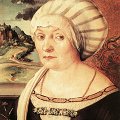 Get
Get  a high-quality picture of
Felicitas Tucher, nee Rieter for your computer or notebook. ‣
It was commissioned in the same year as the diptych of Nicolas and
Elsbeth Tucher (Staatliche Kunstsammlungen, Kassel). They had
approximately the same composition because Wolgemut, Durer's master, had
already done portraits of the members of the Tucher family years before.
Even the setting of the portraits is very similar. The presence of an
embroidered curtain in the background, the almost identical landscape
passage seen through the windows, and lastly, the windowsill set equal
spatial limits to the portraits. The foreshortenings of the landscape
passage are imaginative and mannered, showing roads, lakes, and mountains.
On the road, in the landscape behind the man's portrait, one discerns a
wayfarer; on the path, in the woman's portrait, a man on horseback. The
same clouds are seen in the clear sky behind the man, as in the wife's
portrait, and in Elsbeth Tucher's.
a high-quality picture of
Felicitas Tucher, nee Rieter for your computer or notebook. ‣
It was commissioned in the same year as the diptych of Nicolas and
Elsbeth Tucher (Staatliche Kunstsammlungen, Kassel). They had
approximately the same composition because Wolgemut, Durer's master, had
already done portraits of the members of the Tucher family years before.
Even the setting of the portraits is very similar. The presence of an
embroidered curtain in the background, the almost identical landscape
passage seen through the windows, and lastly, the windowsill set equal
spatial limits to the portraits. The foreshortenings of the landscape
passage are imaginative and mannered, showing roads, lakes, and mountains.
On the road, in the landscape behind the man's portrait, one discerns a
wayfarer; on the path, in the woman's portrait, a man on horseback. The
same clouds are seen in the clear sky behind the man, as in the wife's
portrait, and in Elsbeth Tucher's.
Felicitas holds a carnation, with a bud and a flower. Her plump face is turned to the left, but her gaze, with slightly melancholic eyes, looks to the right. Like her sister-in-law, she wears a gold chain around her neck, and the waistcoat, according to custom, is held by a buckle, which is engraved with the initials of her consort, H. T.
Hans Tucher (1499)
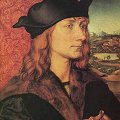 Get
Get  a high-quality picture of
Hans Tucher for your computer or notebook. ‣
It was commissioned in the same year as the diptych of Nicolas and
Elsbeth Tucher (Staatliche Kunstsammlungen, Kassel). They had
approximately the same composition because Wolgemut, Durer's master, had
already done portraits of the members of the Tucher family years before.
Even the setting of the portraits is very similar. The presence of an
embroidered curtain in the background, the almost identical landscape
passage seen through the windows, and lastly, the windowsill set equal
spatial limits to the portraits. The foreshortenings of the landscape
passage are imaginative and mannered, showing roads, lakes, and mountains.
On the road, in the landscape behind the man's portrait, one discerns a
wayfarer; on the path, in the woman's portrait, a man on horseback. The
same clouds are seen in the clear sky behind the man, as in the wife's
portrait, and in Elsbeth Tucher's.
a high-quality picture of
Hans Tucher for your computer or notebook. ‣
It was commissioned in the same year as the diptych of Nicolas and
Elsbeth Tucher (Staatliche Kunstsammlungen, Kassel). They had
approximately the same composition because Wolgemut, Durer's master, had
already done portraits of the members of the Tucher family years before.
Even the setting of the portraits is very similar. The presence of an
embroidered curtain in the background, the almost identical landscape
passage seen through the windows, and lastly, the windowsill set equal
spatial limits to the portraits. The foreshortenings of the landscape
passage are imaginative and mannered, showing roads, lakes, and mountains.
On the road, in the landscape behind the man's portrait, one discerns a
wayfarer; on the path, in the woman's portrait, a man on horseback. The
same clouds are seen in the clear sky behind the man, as in the wife's
portrait, and in Elsbeth Tucher's.
Hans Tucher, a descendant of an old Nuremberg family and an important member of the city council, is depicted in lavish clothes, with a fur collar, a symbol of his high-ranking position. The head, portrayed in a more elevated position than that of his consort, is framed by soft and wavy hair. The eyes, which have slightly different size, have an open gaze, the eyelids are somewhat lowered, the nose is long and sharp, the lips thin: the result is a proud but winning look, which is also emphasized by the points of the beret folded to the back and front. Besides the ring he wears on his thumb, he holds - like Elsbeth Tucher in her portrait - another ring, gold, in his hand as evidence of his marriage, contracted in 1482 with Felicitas. She, in turn, holds a carnation, with a bud and a flower. Her plump face is turned to the left, but her gaze, with slightly melancholic eyes, looks to the right. Like her sister-in-law, she wears a gold chain around her neck, and the waistcoat, according to custom, is held by a buckle, which is engraved with the initials of her consort, H. T.
The combined coat of arms of Tucher-Rieter is depicted on the verso of the Hans Tucher portrait, which became the anterior side of the closed diptych.
Portrait of Elsbeth Tucher (1499)
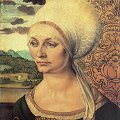 Get
Get  a high-quality picture of
Portrait of Elsbeth Tucher for your computer or notebook. ‣
Elsbeth Tucher (nie Pusch) is portrayed against an ornate brocade
hanging. At the top of the panel is the inscription, 'Elsbeth Niclas
Tucher at 26 years 1499'. This is the right wing of a diptych, but the left
wing portraying her husband Niclas is missing. Elsbeth holds her wedding
ring and the clasp of her blouse is formed with the initials NT,
presumably a gift from her husband. The initials WW worked into her blouse
and the mysterious letters MHIMNSK on the band over her voluminous
headscarf have so far defied interpretation. Just visible on her shoulders
is a gold necklace, evidence of her social standing. Above the parapet on
the left of the panel is a landscape, with a wood-fringed lake leading to
distant mountains, set beneath a stormy sky.
a high-quality picture of
Portrait of Elsbeth Tucher for your computer or notebook. ‣
Elsbeth Tucher (nie Pusch) is portrayed against an ornate brocade
hanging. At the top of the panel is the inscription, 'Elsbeth Niclas
Tucher at 26 years 1499'. This is the right wing of a diptych, but the left
wing portraying her husband Niclas is missing. Elsbeth holds her wedding
ring and the clasp of her blouse is formed with the initials NT,
presumably a gift from her husband. The initials WW worked into her blouse
and the mysterious letters MHIMNSK on the band over her voluminous
headscarf have so far defied interpretation. Just visible on her shoulders
is a gold necklace, evidence of her social standing. Above the parapet on
the left of the panel is a landscape, with a wood-fringed lake leading to
distant mountains, set beneath a stormy sky.
Durer also painted matching portraits of the brother of Niclas, Hans Tucher and his wife Felicitas (nie Rieter). In this diptych, it is the husband who holds a ring and his wife a flower.
Portrait of Oswolt Krel (1499)
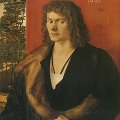 Get
Get  a high-quality picture of
Portrait of Oswolt Krel for your computer or notebook. ‣
This portrait comes from the collection of the Princes
Oettingen-Wallerstein, who had acquired it in 1812; if has been in its
present location since 1928. It is presumed that Oswolt Krell, a merchant
for the Ravensburg House in Nuremberg from 1495 to 1503, had asked the
artist for a true portrait of representation. Its notable size, similar to
that adopted by Durer for the portrait of his father two years earlier,
and its setting, a half-length, suggests this. In this way, it differs from
the Tucher portraits, which were intended for private use.
a high-quality picture of
Portrait of Oswolt Krel for your computer or notebook. ‣
This portrait comes from the collection of the Princes
Oettingen-Wallerstein, who had acquired it in 1812; if has been in its
present location since 1928. It is presumed that Oswolt Krell, a merchant
for the Ravensburg House in Nuremberg from 1495 to 1503, had asked the
artist for a true portrait of representation. Its notable size, similar to
that adopted by Durer for the portrait of his father two years earlier,
and its setting, a half-length, suggests this. In this way, it differs from
the Tucher portraits, which were intended for private use.
The background, as in the Tucher portraits (Schlossmuseum, Weimar), is divided between the curtain and landscape passage, unlike those, however, it is divided rather unevenly. The bright red curtain is wide and occupies most of the space on the right; the landscape, on the left, is reduced to a foreshortening that shows a small part of a river that meanders toward the back, behind a group of tall trees. The windowsill that separated the subject from the landscape in the Tucher paintings is absent. The figure represented, set with obvious grandiosity, is found in front of the curtain, highlighted by intense colour.
The large fur-lined cloak is casually placed on the right shoulder only, to show, on the left side, the rich black garment with the puffed sleeve. To the disorderly folds of the cloak correspond the parallel horizontal folds of the sleeve and the vertical ones of the garment. The three-quarter position allows the painter to bring out the quality of the attire: the fur, silk shirt, and gold chain. The careful, fastidious representation of these meaningful details creates a powerful foundation for the setting of the head: vigorous, strong features, the pronounced nose and the strong-willed mouth, the furrowed eyebrows, as if from a sudden start or fright that makes him direct his gaze off to the side behind him. Everything works to make his face threateningly severe, which even the soft, light brown hair framing him does not attenuate. To the energetic expression of the face corresponds the nervous look of his left hand clutching his cloak and that of the contraction of the knotted fingers of the right hand that leans on an invisible window sill.
Colour, form, and proportion heighten the expression of supreme resolution, an expression that is the result of a serious psychological study that Durer conducted on the merchant, who was the same age as the artist and who was later to become the mayor of Lindau, his native city.
The two side panels that represent two "sylvan men" are wings to the portrait. They bear the heraldic shields of the subject and his wife, Agathe von Esendorf. They originally let the portrait be closed from the retro; one could imagine, then, that despite the large dimensions, the painting was to be conserved closed. The present frame has been made recently.
Portrait of St. Sebastian with an Arrow (1499)
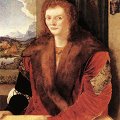 Get
Get  a high-quality picture of
Portrait of St. Sebastian with an Arrow for your computer or notebook. ‣
This primitive portrait has been partially repainted and transformed
into a Saint Sebastian with a large halo. Originally, the man wore a beret
and held a broken arrow in his left hand, which rests on the window sill,
as you can still see today. In the whole painting, only the landscape
passage with the lake and the castle in front of the mountains have
remained in its original state. The arrow is a fairly rare attribute for a
portrait, although, in this case, it could become credible if Sebastian
Imhoff were the person portrayed, as Thode had previously proposed when
the painting was first published in 1893. Sebastian Imhoff was elected to
the position of consul of the Fondaco dei Tedeschi in Venice in 1493.
a high-quality picture of
Portrait of St. Sebastian with an Arrow for your computer or notebook. ‣
This primitive portrait has been partially repainted and transformed
into a Saint Sebastian with a large halo. Originally, the man wore a beret
and held a broken arrow in his left hand, which rests on the window sill,
as you can still see today. In the whole painting, only the landscape
passage with the lake and the castle in front of the mountains have
remained in its original state. The arrow is a fairly rare attribute for a
portrait, although, in this case, it could become credible if Sebastian
Imhoff were the person portrayed, as Thode had previously proposed when
the painting was first published in 1893. Sebastian Imhoff was elected to
the position of consul of the Fondaco dei Tedeschi in Venice in 1493.
The painting shows many Durerian portrait characteristics of this era, such as the landscape beyond the window and the resting of the hands in the window sill; the minimum of space between the window sill and the back wall; and the curtain that partially covers it.
Self-Portrait in a Fur-Collared Robe (1500)
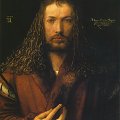 Get
Get  a high-quality picture of
Self-Portrait in a Fur-Collared Robe for your computer or notebook. ‣
The last of Durer's three magnificent self-portraits was painted early
in 1500, before his 29th birthday on 21 May. The picture is proudly
inscribed: 'Thus I, Albrecht Durer from Nuremburg, painted myself with
indelible colours at the age of 28 years.' It is a sombre image, painted
primarily in browns, set against a plain dark background.
a high-quality picture of
Self-Portrait in a Fur-Collared Robe for your computer or notebook. ‣
The last of Durer's three magnificent self-portraits was painted early
in 1500, before his 29th birthday on 21 May. The picture is proudly
inscribed: 'Thus I, Albrecht Durer from Nuremburg, painted myself with
indelible colours at the age of 28 years.' It is a sombre image, painted
primarily in browns, set against a plain dark background.
The face is striking for its resemblance to the head of Christ. In late medieval art, Jesus was traditionally presented in this manner, looking straight ahead in a symmetrical pose. Christ's brown hair in these images is parted towards the middle and falls over the shoulders. For the first and last time in Western art history, an artist was to portray himself in a Christ-like scheme. Given his idealized appearance as the underdrawing shows, his nose was originally irregular in shape - Durer is approaching us in "imitatio Christi", in imitation of Christ. He has a short beard and moustache. Durer has even painted himself with brown hair, although the other self-portraits show that it was actually reddish-blond. Durer deliberately set out to create a Christ-like image, with his hand raised to his chest almost in a pose of blessing. But this was no gesture of arrogance or blasphemy. It was a statement of faith: Christ was the son of God and God had created Man. For Durer, the painting was an acknowledgment that artistic skills were a God-given talent.
However, Durer has subtly departed from the traditional image of Christ in his self-portrait. Despite initial appearances, the picture is not quite symmetrical. The head lies just off the centre of the panel to the right and the parting of the hair is not exactly in the middle, with the strands of hair falling a little differently on the two sides. The eyes stare slightly towards the left of the panel. Durer also wears contemporary clothing, a fashionable fur-lined mantle. The result is a highly personal image, one whose 'indelible colours' still influence the way we imagine Durer looked in his later years.
The deceptive illusionism in which the picture is painted is also, however, a reference to the classical artistic legend about Apelles, with whom he had been compared by contemporary humanists.
Portrait of Young Man (1500)
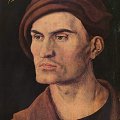 Get
Get  a high-quality picture of
Portrait of Young Man for your computer or notebook. ‣
Durer's paintings include altarpieces, religious pictures and some
outstanding portraits. Although he began by working in the German late
Gothic tradition, Durer was to introduce the Renaissance to Germany with
his pure compositions in which the sure touch of the draughtsman is always
evident. With his workshop and followers he marked out the lines of
development of the new style for later years.
a high-quality picture of
Portrait of Young Man for your computer or notebook. ‣
Durer's paintings include altarpieces, religious pictures and some
outstanding portraits. Although he began by working in the German late
Gothic tradition, Durer was to introduce the Renaissance to Germany with
his pure compositions in which the sure touch of the draughtsman is always
evident. With his workshop and followers he marked out the lines of
development of the new style for later years.
This small picture - a portrait of a youth, painted in brilliant, warm colours - is sometimes ascribed to Durer's pupils (Hans Suss von Kulmbach or Hans Baldung Grien). Some scholars believe to recognize in the sitter Durer's brother Andreas; however the smooth features and simple attire hardly provide enough clues for identifying the sitter. However, a silverpoint drawing by Durer in the Albertina Collection in Vienna shows the same model in a similar pose, clearly indicated in the inscription as Endres Durer, the painter's younger brother.
Portrait of a Young Venetian Woman (1505)
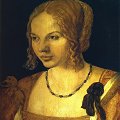 Get
Get  a high-quality picture of
Portrait of a Young Venetian Woman for your computer or notebook. ‣
The portrait is one of the first works of the artist during his second
sojourn in Venice. It was painted in the autumn or in the winter of 1505.
From the portraits, an extraordinary charm emanates, which cannot be
merely attributable to the shades of brown and gold of the hairdo and
clothing, which are set apart from the uniform black background. It is
really the beauty of the portrait that fascinates in its entirety and in
its variety of details. It is the slight wave of the hair on the clear,
high forehead that imperceivably becomes curls caressing the girl's
cheeks. It is the dreamy gaze that shows, under the slightly lowered
eyelids, the radiant, black eyes. It highlights the play of light on the
forehead and on the cheeks. It is the candour of this face, of the neck
and chest, emphasized by a neckline of a contrasting colour, that evoke the
image of the ideal purity of a girl. With great ability, the artist
includes in this image a long and pronounced nose and large, sensual lips,
immersing the whole figure in a light that reveals the important influence
of the Venetian school, and, in particular, that of Giovanni Bellini.
a high-quality picture of
Portrait of a Young Venetian Woman for your computer or notebook. ‣
The portrait is one of the first works of the artist during his second
sojourn in Venice. It was painted in the autumn or in the winter of 1505.
From the portraits, an extraordinary charm emanates, which cannot be
merely attributable to the shades of brown and gold of the hairdo and
clothing, which are set apart from the uniform black background. It is
really the beauty of the portrait that fascinates in its entirety and in
its variety of details. It is the slight wave of the hair on the clear,
high forehead that imperceivably becomes curls caressing the girl's
cheeks. It is the dreamy gaze that shows, under the slightly lowered
eyelids, the radiant, black eyes. It highlights the play of light on the
forehead and on the cheeks. It is the candour of this face, of the neck
and chest, emphasized by a neckline of a contrasting colour, that evoke the
image of the ideal purity of a girl. With great ability, the artist
includes in this image a long and pronounced nose and large, sensual lips,
immersing the whole figure in a light that reveals the important influence
of the Venetian school, and, in particular, that of Giovanni Bellini.
With reference to some of the details, it has been repeatedly made known that the portrait is unfinished. It is probable that Durer deliberately did not give the same intensity to the left ribbon as to the right: on the one hand, so as to not overwhelm the charm of the dark eyes; on the other, so as to support the subtle chromatic effect of the bodice that, from the design of the gold ribbons, contributes to the overall charm of the painting.
This charm is also shown in the movement in the double rows of pearls, interrupted by the darker shapes of doubled cones, making the pendant curve slightly from the neck.
Among Durer's works, there is not a more beautiful portrait of a woman. Indeed, it has led one to think that there was a rather intimate relationship between the artist and the model. Some see the woman as a courtesan, others define her as an instinctive, languorous, and melting beauty.
Portrait of Burkard von Speyer (1506)
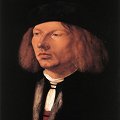 Get
Get  a high-quality picture of
Portrait of Burkard von Speyer for your computer or notebook. ‣
This striking portrait, painted in Venice, shows a thoughtful young
man, richly dressed and dramatically set against a black background. His
thick ginger hair, partly hidden by his dark hat, frames his face. The
small part of his red shirt showing adds a dramatic touch of colour.
Charles I acquired this work for the Royal Collection.
a high-quality picture of
Portrait of Burkard von Speyer for your computer or notebook. ‣
This striking portrait, painted in Venice, shows a thoughtful young
man, richly dressed and dramatically set against a black background. His
thick ginger hair, partly hidden by his dark hat, frames his face. The
small part of his red shirt showing adds a dramatic touch of colour.
Charles I acquired this work for the Royal Collection.
The sitter was identified as Burkard von Speyer after it was realized that he looks just like the man in a miniature in Weimar by an unknown artist, also dated 1506 and inscribed with his name. Nothing more is known about him, although presumably he originally came from Speyer, a town on the Rhine near Heidelberg. Burkard von Speyer also appears in The Altarpiece of the Rose Garlands. Wearing the same clothing, he is on the left side of the picture, just to the right of the first kneeling cardinal.
Portrait of a Venetian Woman (1507)
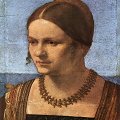 Get
Get  a high-quality picture of
Portrait of a Venetian Woman for your computer or notebook. ‣
The painting is poorly conserved. Almost all the final layers of colour
are missing. The eyes have been restored. Because of the absence of the
topmost layer of colour, the painting has acquired a soft chromatic
shading. Even if we know that Durer executed it during his second sojourn
in Italy, probably in the autumn of 1506 after the Feast of the Rose
Garlands, workmanship seems particularly "Venetian." The refinement of the
artist is clearly absent in the sketching of the hair. Some object is
discernible in the curl hanging to the left.
a high-quality picture of
Portrait of a Venetian Woman for your computer or notebook. ‣
The painting is poorly conserved. Almost all the final layers of colour
are missing. The eyes have been restored. Because of the absence of the
topmost layer of colour, the painting has acquired a soft chromatic
shading. Even if we know that Durer executed it during his second sojourn
in Italy, probably in the autumn of 1506 after the Feast of the Rose
Garlands, workmanship seems particularly "Venetian." The refinement of the
artist is clearly absent in the sketching of the hair. Some object is
discernible in the curl hanging to the left.
Only a few traces of the hairnet have been preserved, and the sky blue of the background, which is inexplicably divided into two sections, is probably no longer its original shade. In its original state, however, this half-bust must have been in the Venetian style, because of her full, soft shapes, delicately modeled with a measured use of light. We must count this painting among the most beautiful works Durer produced during his second sojourn in Venice.
The various attempts to identify the model - for example, as Agnes Durer, because of the letters AD on the trimming of the clothes or the woman with her head turned in the middle right of the Feast of the Rose Garlands - have not held up to criticism. The letters are probably the initials of a motto.
Portrait of a Young Girl (1507)
 Get
Get  a high-quality picture of
Portrait of a Young Girl for your computer or notebook. ‣
This small painting was in the collection of the Imhoff family of
Nuremberg, and cited in their inventory from 1573-74 until 1628. In 1633,
it was handed over, with the title Portrait of a Young Girl, with other
works by Durer, to Abraham Bloemart, an artist and merchant from
Amsterdam. In 1899, the portrait reappears in London, and the firm P. and
D. Colnaghi donated it to the Berlin art gallery.
a high-quality picture of
Portrait of a Young Girl for your computer or notebook. ‣
This small painting was in the collection of the Imhoff family of
Nuremberg, and cited in their inventory from 1573-74 until 1628. In 1633,
it was handed over, with the title Portrait of a Young Girl, with other
works by Durer, to Abraham Bloemart, an artist and merchant from
Amsterdam. In 1899, the portrait reappears in London, and the firm P. and
D. Colnaghi donated it to the Berlin art gallery.
The delicate girl is portrayed with soft, curly blond hair, slightly dreamy her eyes, one somewhat lower than the other, a gentle, melancholic gaze; and well-defined, slightly parted lips. The red beret, worn sideways, with a little slit to the side, with a long red ruby and black pearl pendant, gives her a slightly cheeky air.
The square green border of the red bodice sets off the upper part of her body. All these details put together have led to various interpretations. In addition to the fact that the "girl," when sold by the Imhoffs, was transformed into a "boy," Panofsky (1955) attributes an androgynous nature to her that could reveal the possible homosexual tendencies of the artist. A teasing letter of 1507 from the canonical Lorenz Behaim of Bamberg and the fact that the portrait does not seem to have been ordered would support this hypothesis. It has also been debated whether the painting was executed in Venice or after Durer's return to Nuremberg. Considering the clothing to be typically German, there is no doubt as to its provenance.
Portrait of a Young Man (1506)
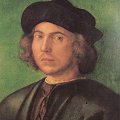 Get
Get  a high-quality picture of
Portrait of a Young Man for your computer or notebook. ‣
This painting probably came from the collection of Rudolph II. Durer
returned to Nuremberg in the spring of 1507, after his second sojourn in
Venice. Opinions differ as to the whereabouts of the painting of this
portrait, which demonstrates, on the one hand, all the pictorial
characteristics of the Venetian tradition (following in the steps of
Giovanni Bellini, or Vicenzo Catena), and shows the depiction of a youth
wearing a typically Venetian beret, which would mean it was Venice; on the
other hand, the type of wood used for the panel, lindenwood, would have
its execution in Nuremberg, upon his return. It should be recalled that
Durer only used panels of poplar while in Venice, or, rarely, elm. The
alternative, regarding the setting and brightness of the portrait being
typically Venetian, in fact, is purely speculative.
a high-quality picture of
Portrait of a Young Man for your computer or notebook. ‣
This painting probably came from the collection of Rudolph II. Durer
returned to Nuremberg in the spring of 1507, after his second sojourn in
Venice. Opinions differ as to the whereabouts of the painting of this
portrait, which demonstrates, on the one hand, all the pictorial
characteristics of the Venetian tradition (following in the steps of
Giovanni Bellini, or Vicenzo Catena), and shows the depiction of a youth
wearing a typically Venetian beret, which would mean it was Venice; on the
other hand, the type of wood used for the panel, lindenwood, would have
its execution in Nuremberg, upon his return. It should be recalled that
Durer only used panels of poplar while in Venice, or, rarely, elm. The
alternative, regarding the setting and brightness of the portrait being
typically Venetian, in fact, is purely speculative.
The portrait almost aggressively approaches the spectator. It is dominated by a light, slightly reddish face, an intense, far-off gaze, a short and robust nose, a wide mouth, and turgid lips surmounted by a hint of downy hair. Even the beard under the chin is delicate and contrasts with the almost frizzy hair, painted with an extremely thin brush. Despite the fact that the painting is not completely preserved in this area, one can still appreciate the extraordinary skill of execution. One appreciates above all the difference between the stroke used for the hair and the one, just as skillful though different, adopted for the hairs of the fur collar, giving a showy trim to the coat. His talent drew praise from the Venetians and particular admiration from Giovanni Bellini. The snow-white of the shirt represents the third note of colour of the painting, next to the delicate pink of the flesh and to the black, found in the elegantly worn beret and in the clothing, silhouetted against the similarly black background.
He employs what he learned from Venetian painting and his special talent for painting, with very fine strokes for hair and fur - a talent that markedly distinguishes him from his Venetian colleagues. Durer thus manages to vivify even a face like this one, that except for the mouth, has rigid and immobile features, and for that, on the whole, is not very expressive.
On the reverse side, without a preparatory drawing and with light brush strokes, an ugly old woman is painted, who winks rather obscenely. She reveals her nude breast and holds a bag of coins. With the original frame lost, it is unfortunately impossible to know if this small painting was to be part of a diptych, as some have put forward.
Emperor Charlemagne (1512)
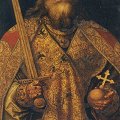 Get
Get  a high-quality picture of
Emperor Charlemagne for your computer or notebook. ‣
Durer's only commission for panel paintings from Nuremberg's city
council was for a pair of portraits of the Emperors Charlemagne and
Sigismund. These were ordered for the Treasure Chamber in the Schopper
House, where the imperial regalia were kept the night before they went on
ceremonial display on the Friday after Easter. For the rest of the year
the regalia were housed in the Church of the Hospital of the Holy Ghost.
Durer was probably commissioned for the portraits in 1510 and received his
final payment three years later. His panels are believed to have been
ordered to replace two earlier works, now lost, which had been painted
soon after the regalia were brought to Nuremberg in 1424.
a high-quality picture of
Emperor Charlemagne for your computer or notebook. ‣
Durer's only commission for panel paintings from Nuremberg's city
council was for a pair of portraits of the Emperors Charlemagne and
Sigismund. These were ordered for the Treasure Chamber in the Schopper
House, where the imperial regalia were kept the night before they went on
ceremonial display on the Friday after Easter. For the rest of the year
the regalia were housed in the Church of the Hospital of the Holy Ghost.
Durer was probably commissioned for the portraits in 1510 and received his
final payment three years later. His panels are believed to have been
ordered to replace two earlier works, now lost, which had been painted
soon after the regalia were brought to Nuremberg in 1424.
The half length pictures are larger than life. No likenesses are known of Charlemagne, who ruled from 800-14, and Durer therefore invented his portrait, presenting him frontally in an imposing posture. His interpretation of Charlemagne's appearance was to influence depictions of the Emperor until well into the nineteenth century. For Sigismund, who ruled from 1410-37, Durer must have had access to a portrait done during his reign.
The two paintings include the appropriate coats of arms, the German eagle and French fleur-de-lis for Charlemagne and the arms of the five territories ruled by Sigismund, the German Empire, Bohemia, Old and New Hungary and Luxembourg. Inscriptions name the two men and state the number of years they ruled, 14 years for Charlemagne and 28 for Sigismund. Around the four sides of the panels are explanatory texts on the frames. The first records: 'Charlemagne reigned for 14 years. He was the son of the Frankish King Pippin, and Roman Emperor. He made the Roman Empire subject to German rule. His crown and garments are put on public display annually in Nuremberg, together with other relics.' On the second panel is the text: 'Emperor Sigismund ruled for 28 years. He was always well-disposed to the city of Nuremberg, bestowing upon it many special signs of his favour. In the year 1424, he brought here from Prague the relics that are shown every year.'
The idealized portrait of Emperor Charlemagne was intended for the "Heiltumskammer" in the Schoppersche House by the marketplace, together with the portrait of Emperor Sigismund of Poland (also in Nuremberg). This was where the coronation insignia and relics were kept, which were put on display once a year at the so-called "Heiltumsweisungen." The physiognomy of Charlemagne, shown in the magnificent original coronation robes, is reminiscent of depictions of God the Father. The crown, sword and imperial orb were prepared by Durer in sketches. The German imperial coat of arms and French coat of arms with the fleur-de-lis are emblazoned at the top.
Emperor Sigismund (1512)
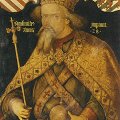 Get
Get  a high-quality picture of
Emperor Sigismund for your computer or notebook. ‣
Although the two panels were originally designed as a diptych, they
were ultimately displayed separately. Other texts on the reverse of the
panels suggest that the painted side was normally hung facing the wall,
with the portraits only being shown on special occasions, presumably for
the annual display of the regalia. The two panels were hung on either side
of the shrine in which the relics were housed.
a high-quality picture of
Emperor Sigismund for your computer or notebook. ‣
Although the two panels were originally designed as a diptych, they
were ultimately displayed separately. Other texts on the reverse of the
panels suggest that the painted side was normally hung facing the wall,
with the portraits only being shown on special occasions, presumably for
the annual display of the regalia. The two panels were hung on either side
of the shrine in which the relics were housed.
Durer prepared studies of the individual pieces of the regalia and reproduced them with great accuracy. Charlemagne wears the imperial crown and brandishes his sword and orb. Sigismund has a Gothic crown and holds a sceptre and orb. The annual display of the imperial regalia ended in 1525 and Durer's panels were then moved to the city hall. Since 1880 they have been on loan to the Germanisches Museum in Nuremberg. As for the regalia, the Habsburgs later took them to Vienna where they remained in the imperial treasury, except for a brief period when they were seized by the Nazis and returned to Nuremberg.
Durer had originally planned the two imperial portraits of Charlemagne (also in Nuremberg) and Sigismund to be a foldable diptych. In accordance with the prescriptions of the Nuremberg town council, who had commissioned the works, the two portraits were supposed to be based on the paintings which had previously decorated the "Heiltumskammer" in the Schoppersche House by the marketplace, where every year the state jewels were kept for a short time. Emperor Sigismund is turned towards Charlemagne. The portrait, which is rather wooden in appearance when compared to other portraits by Durer, presumably was based on a miniature copy in a portrait book by Hieronimus Beck of Leopoldsdorf, which is in the Kunsthistorisches Museum in Vienna. The coats of arms of the German Empire, Bohemia, old Hungary, new Hungary and Luxembourg appear at the top of the painting.
Portrait of Michael Wolgemut (1516)
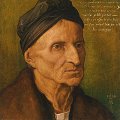 Get
Get  a high-quality picture of
Portrait of Michael Wolgemut for your computer or notebook. ‣
After he had achieved great fame, Durer depicted the master who had
taught him to paint. On it he inscribed: 'This portrait was done by
Albrecht Durer of his teacher, Michael Wolgemut, in 1516', to which he
later added, 'and he was 82 years old, and he lived until 1519, when he
departed this life on St Andrew's Day morning before sunrise.' It is
unclear from the inscription whether Wolgemut was 82 when he died or when
the portrait had been painted three years earlier.
a high-quality picture of
Portrait of Michael Wolgemut for your computer or notebook. ‣
After he had achieved great fame, Durer depicted the master who had
taught him to paint. On it he inscribed: 'This portrait was done by
Albrecht Durer of his teacher, Michael Wolgemut, in 1516', to which he
later added, 'and he was 82 years old, and he lived until 1519, when he
departed this life on St Andrew's Day morning before sunrise.' It is
unclear from the inscription whether Wolgemut was 82 when he died or when
the portrait had been painted three years earlier.
Michael Wolgemut (1434/7-1519) had one of the largest artist's workshops in Germany. Durer had served his apprenticeship there from 1486 until 1489 and Wolgemut must have been proud to have witnessed his former pupil's rapid success. In Durer's portrait, everything is focused on the head, set against a neutral green background. The old man's features are not disguised, from his sunken eyes and gaunt cheeks to the loose skin around his neck. Wolgemut wears a fur-lined coat and a simple hat or scarf, perhaps the headgear he would have worn in his workshop to keep off the dust. His eyes are still alert and he has a thoughtful expression. Durer does not depict a pitiable man, but marvels at his indomitable spirit.
Portrait of a Cleric (1516)
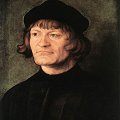 Get
Get  a high-quality picture of
Portrait of a Cleric for your computer or notebook. ‣
The painting was considered in Nuremberg (1778) to be of Johann Dorsch,
an Augustinian friar who had converted quite early on to Lutheranism. This
identification, however, was challenged by various critics, since Dorsch
became the parish priest of Saint John's in Nuremberg in 1528. Some have
hypothesized that it was a portrait by Huldrych Zwingli, the great Swiss
reformer; but only side profile portraits of him exist, which do not give
rise to a fair comparison or to a reliable attribution. Most critics would
opt for the former identification, also because, according to more recent
studies, the meeting between Zwingli and Durer could not have occurred
before 1519, on the occasion of a mission in Zurich in which he
participated with his friend Pirckheimer and Martin Tucher.
a high-quality picture of
Portrait of a Cleric for your computer or notebook. ‣
The painting was considered in Nuremberg (1778) to be of Johann Dorsch,
an Augustinian friar who had converted quite early on to Lutheranism. This
identification, however, was challenged by various critics, since Dorsch
became the parish priest of Saint John's in Nuremberg in 1528. Some have
hypothesized that it was a portrait by Huldrych Zwingli, the great Swiss
reformer; but only side profile portraits of him exist, which do not give
rise to a fair comparison or to a reliable attribution. Most critics would
opt for the former identification, also because, according to more recent
studies, the meeting between Zwingli and Durer could not have occurred
before 1519, on the occasion of a mission in Zurich in which he
participated with his friend Pirckheimer and Martin Tucher.
As in the portrait of Wolgemut (Germanisches Nationalmuseum, Nuremberg), Durer succeeds in effectively expressing the vigorous personality of the subject, modeling the head with a slight rotation leftward, toward the light, and framing it with a severe black attire against a green background. The fine brush strokes, especially for the hair and eyelashes, are well preserved.
Portrait of Emperor Maximilian I (1519)
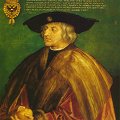 Get
Get  a high-quality picture of
Portrait of Emperor Maximilian I for your computer or notebook. ‣
Maximilian I of Austria (1459-1519) became head of the Habsburgs in
1493 and was elected Holy Roman Emperor in 1508. He was a learned ruler
with a strong interest in the arts. Durer first met him during a visit to
Nuremberg in 1512 and was commissioned to work on the gigantic woodcuts of
The Triumphal Arch and The Triumphal Procession, as well as decorations
for Maximilian's prayer book. In 1515 he was awarded an annual payment of
100 florins by the Emperor.
a high-quality picture of
Portrait of Emperor Maximilian I for your computer or notebook. ‣
Maximilian I of Austria (1459-1519) became head of the Habsburgs in
1493 and was elected Holy Roman Emperor in 1508. He was a learned ruler
with a strong interest in the arts. Durer first met him during a visit to
Nuremberg in 1512 and was commissioned to work on the gigantic woodcuts of
The Triumphal Arch and The Triumphal Procession, as well as decorations
for Maximilian's prayer book. In 1515 he was awarded an annual payment of
100 florins by the Emperor.
On 28 June 1518 Durer had sketched Maximilian during the Imperial Diet at Augsburg. He inscribed the drawing: 'This is Emperor Maximilian, whom I, Albrecht Durer, portrayed up in his small chamber in the tower at Augsburg on the Monday after the feast day of John the Baptist in the year 1518.' In the relatively informal sketch Durer captured a hint of the fatigued resignation of the 59 year-old ruler.
Maxmilian I died on 12 January 1519 and Durer then used his drawing as the basis for a woodcut and two painted portraits, one in tempera (Germanisches Nationalmuseum, Nuremberg) and this one in oil. These finished works are formal portraits and lack some of the human character which comes out in the original sketch. In the oil portrait, the Emperor is dressed in an elegant fur, which Durer has painted with great care. Instead of an orb, the Emperor holds a broken pomegranate, a symbol of the Resurrection and Maximilian's personal emblem. At the top of the picture is the Habsburg coat of arms with the double-headed eagle and a lengthy inscription on Maximilian's achievements. The Emperor looks aloof and withdrawn, an expression of his dignity.
Jakob Fugger, the Wealthy (1520)
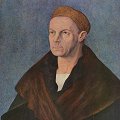 Get
Get  a high-quality picture of
Jakob Fugger, the Wealthy for your computer or notebook. ‣
The presence of this portrait is documented, in the eighteenth century,
in the gallery of the elector of Bavaria. Because of successive
restorations, the top layer of colour is missing.
a high-quality picture of
Jakob Fugger, the Wealthy for your computer or notebook. ‣
The presence of this portrait is documented, in the eighteenth century,
in the gallery of the elector of Bavaria. Because of successive
restorations, the top layer of colour is missing.
During the Diet of Augsburg, in 1518, Durer portrayed Jakob Fugger in a charcoal drawing. The final painting, on canvas, differs from the drawing in the wealthier clothing of the subject, and, above all, in the framing: a half-bust in the drawing, a half-length in the painting.
Jakob Fugger of Augsburg (1459-1525), the wealthiest merchant of his day, learned the art of commerce in Venice. He possessed a network of business agencies throughout Europe. His was the most important banking institution in Europe, and he had the monopoly of silver and copper mines. He obtained the right to mint the coins of the Vatican from Julius II, Leo X, and Adrian VI, and he had an important role in the system of tax collection and payment of indulgences from the Vatican coffers. He heavily financed the political and military undertakings of Maximilian I and Charles V: just for the election of the latter, he contributed 300,000 florins. In 1508, Maximilian I conferred him a noble title, and Leo X nominated him Count Palatine of the Lateran. In 1519, he established in Augsburg the "Fuggerei," a small city within the city, consisting of 106 small houses intended for the most needy citizens.
The outer edges of his garments and fur coat, crossing and overlapping, create an ascendant pyramid effect, which solidly sets off the portrait. At the same time, his garments sharply contrast with his face, hard and severe, atop a bull neck. Only the clear complexion of the flesh, painted with extremely fine brush strokes, which is detached from a delicate blue background, attenuates his dynamism and severity. The position of the head denotes firmness and self-assurance, and the eyes look away, possibly to indicate a farsightedness. The wide forehead, lined with a simply-fashioned gold beret, and the thin, pressed lips, give him the look of a man who - at least according to Durer's interpretation - has a strong personality and no need of decoration to assert himself.
This impressive characterization, if somewhat idealized, along with the one of Durer's father of 1497 (National Gallery, London), is probably one of the most significant of portraiture in that era in Europe.
Portrait of Bernhard von Reesen (1521)
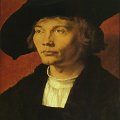 Get
Get  a high-quality picture of
Portrait of Bernhard von Reesen for your computer or notebook. ‣
The man in the portrait holds a message on which the first few letters
of his name can be read 'Bernh', the rest being hidden by the
fingers of his left hand. This is almost certainly the painting to which
Durer refers in his Antwerp diary in late March 1521, recording that he
had 'made a portrait of Bernhart von Resten in oils' for which he had been
paid eight florins. Durer's reference is probably to Bernhard von Reesen
(1491-1521), a Danzig merchant whose family had important business links
with Antwerp. His name suggests that his family originated from Rees, a
town on the Lower Rhine 100 miles east of Antwerp.
a high-quality picture of
Portrait of Bernhard von Reesen for your computer or notebook. ‣
The man in the portrait holds a message on which the first few letters
of his name can be read 'Bernh', the rest being hidden by the
fingers of his left hand. This is almost certainly the painting to which
Durer refers in his Antwerp diary in late March 1521, recording that he
had 'made a portrait of Bernhart von Resten in oils' for which he had been
paid eight florins. Durer's reference is probably to Bernhard von Reesen
(1491-1521), a Danzig merchant whose family had important business links
with Antwerp. His name suggests that his family originated from Rees, a
town on the Lower Rhine 100 miles east of Antwerp.
Durer's tight composition cuts off the two edges of Reesen's hat, emphasizing his brightly lit face. The dark clothing and hat also draw attention to his features - his pronounced cheekbones, forceful chin and youthful expression. His eyes stare out into the distance. Reesen, who was 30 when he was painted, died from the plague just a few months later in October 1521.
The well-preserved state allows for a full appreciation, from a formal point of view and a pictorial one, the mastery of the painter. He gives the thirty-year-old subject an intense physical and spiritual charm. This work further demonstrates the extraordinary span of Durer's portraiture up until his final years.
Portrait of a Man with Baret and Scroll (1521)
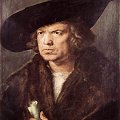 Get
Get  a high-quality picture of
Portrait of a Man with Baret and Scroll for your computer or notebook. ‣
There is an inscription near his head, monogrammed and dated 152?.
The last digit of the date is not clearly legible (1 or 4), but the fact
that the panel is oak indicates that the painting must have been carried
out during Durer's trip to the Netherlands. The hypotheses regarding the
name of the subject are various. The most frequent are: the one of Lorenz
Sterck, an administrator and financial curator of the Brabant and of
Antwerp, and that of Jobst Plankfelt, Durer's innkeeper in Antwerp. These
names are frequently suggested since Durer writes in his diary that he had
done oil portraits of them.
a high-quality picture of
Portrait of a Man with Baret and Scroll for your computer or notebook. ‣
There is an inscription near his head, monogrammed and dated 152?.
The last digit of the date is not clearly legible (1 or 4), but the fact
that the panel is oak indicates that the painting must have been carried
out during Durer's trip to the Netherlands. The hypotheses regarding the
name of the subject are various. The most frequent are: the one of Lorenz
Sterck, an administrator and financial curator of the Brabant and of
Antwerp, and that of Jobst Plankfelt, Durer's innkeeper in Antwerp. These
names are frequently suggested since Durer writes in his diary that he had
done oil portraits of them.
It is difficult to imagine an innkeeper who made himself depicted with a scroll in his hand. Whereas it seems much more plausible that the imposing subject characterized by a severe and scrutinizing gaze - clad in a silk shirt, a cloak with a fur collar, and a large beret - corresponds to a tax collector. But whoever the subject is, the portrait is regardless one of the most beautiful and incisive that Durer ever created. He manages, with an image constrained by such a limited space, to communicate the impression of being in front of a personality of a supremely concentrated energy - and all that by using simple and pale colours, whose effect is unfortunately partly obfuscated by the heavy varnish covering the painting.
Portrait of Hieronymus Holzchuher (1526)
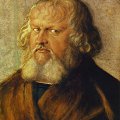 Get
Get  a high-quality picture of
Portrait of Hieronymus Holzchuher for your computer or notebook. ‣
Durer painted this portrait in Nuremberg in 1526, when the sitter was
57 years old. Hieronymus Holzschuher (1469-1529) came from an old Nuremberg
patrician family. In 1500 he was elected junior, and nine years later
senior burgomaster. In 1514 he ranked as one of the seven Elders of the
city government, and on his death in 1529 a commemorative medal bearing
his profile was struck. Holzschuher was a fearless champion of the
reformation movement in Nuremberg. In Durer, who was only slightly
younger, he found both a sympathizer and a friend. When the painter visited
the Netherlands in 1521, he bought presents for Holzschuher, a fact which
he noted in his diary.
a high-quality picture of
Portrait of Hieronymus Holzchuher for your computer or notebook. ‣
Durer painted this portrait in Nuremberg in 1526, when the sitter was
57 years old. Hieronymus Holzschuher (1469-1529) came from an old Nuremberg
patrician family. In 1500 he was elected junior, and nine years later
senior burgomaster. In 1514 he ranked as one of the seven Elders of the
city government, and on his death in 1529 a commemorative medal bearing
his profile was struck. Holzschuher was a fearless champion of the
reformation movement in Nuremberg. In Durer, who was only slightly
younger, he found both a sympathizer and a friend. When the painter visited
the Netherlands in 1521, he bought presents for Holzschuher, a fact which
he noted in his diary.
The artist has filled almost the whole of the upper half of the panel with his subject's powerful head, for which the upper part of the body, clad in heavy fur, seems merely to serve as a plinth, attention being focused on the features. In this portrait Durer has reproduced details with incredible fidelity. The fine brush has rendered the thick, wavy hair, which has receded somewhat over the forehead, with all the delicacy of a pen-and-ink drawing. At the same time, the face and the full lips are strongly modelled and determine the full-blooded vitality of the man. Reflected in the sitter's eyes are the window-bars of the room in which Durer worked. Durer himself fitted to the frame a sliding cover bearing Holzschuher's coat of arms; frame and cover are still extant in their original state and have served for centuries to protect the picture.
Durer was renowned for his ability to paint details, such as hair, realistically and it was pictures like this which are said to have led to his famous conversation with Giovanni Bellini in 1505 or 1506. The elderly Venetian painter had asked Durer for one of the brushes which he used to execute his painstaking portraits. Durer then handed Bellini a brush identical to ones the Venetian artist already used. 'I do not mean this, I mean the brushes you use to paint several hairs with one touch,' Bellini responded. Durer picked up the brush and demonstrated how he painted.
In 1651 when the painter and art-historian Joachim von Sandrart was commissioned by some distinguished personality, possibly the Elector Maximilian I of Bavaria, to purchase the panel, his offer was turned down on the ground that it was intended to remain in the subject's family as a permanent memorial to him. During the eighteenth century the picture remained, well looked-after, in a groundfloor room of the family residence. Then, with the growth of Romanticism in the early nineteenth century, there was a revival of interest in German painting and this famous portrait was brought out into the light of day. The new-found enthusiasm for Durer's art made this particular portrait more popular than almost any other work of his. When it was publicly exhibited for the first time in Munich in 1869, it had already been accepted as epitomizing the old German patrician class. The portrait remained in the possession of Holzschuher's descendants in Nuremberg until it was purchased for the Berlin Gallery in 1884.
Portrait of Jakob Muffel (1526)
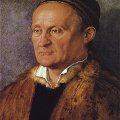 Get
Get  a high-quality picture of
Portrait of Jakob Muffel for your computer or notebook. ‣
Inscription in the top left: EFFIGIES JAKOBI MVFFEL AETATIS SVAE ANNO
LV SALVTIS VERO MDXXVI; monogrammed.
a high-quality picture of
Portrait of Jakob Muffel for your computer or notebook. ‣
Inscription in the top left: EFFIGIES JAKOBI MVFFEL AETATIS SVAE ANNO
LV SALVTIS VERO MDXXVI; monogrammed.
This painting was passed into a private Russian collection from the Schenborn collection in Pommersfelden, where it was in 1867. In 1870, in Saint Petersburg, it was transferred on canvas. In 1883, it was acquired in an auction from the Narischkin collection, in Paris, for the Berlin art gallery.
Like Hieronymus Holzschuher, Jakob Muffel (1471-1526) was one of the dignitaries of the city of Nuremberg and was a friend of Albrecht Durer's and Willibald Pirckheimer's. He had been a councilor since 1502, and was the "Alter Burgermeister" (Old Mayor) in 1514 as well as being one of the city's septemvirs. The goal in this portrait is not to idealize him but to produce a character portrait that was painted with the highest possible degree of naturalism. Details such as the fine wrinkles on his forehead, rosy flesh tones and subtle differentiation of the materials of his garments display a highly cultured style of painting.
Jakob Muffel died 26 April 1526; the portrait, dated 1526, must have been from the first months of that year. Even if its dimensions correspond roughly to those of the portraits Durer executed in the Netherlands, it stands out from these for some particulars.
As in the Portrait of Hieronymus Holzschuher (also in Berlin), of the same year, Durer brings the head close to the spectator, moving it upward at the same time. There is no sign whatsoever of any decoration or of representativeness. On the contrary, the artist dwells affectionately on the details of the physiognomy of the subjects. He retouches the pronounced nose of Jakob in the shape of a duck's beak and brings out the calm expression of the open face, with the high forehead edged by a simple black beret decorated with three golden ribbons: a personal and incisive way to expose the incorruptible virtue of his friend.
Other works
Alliance Coat of Arms of the Durer and Holper Families (1490)
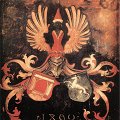 Get
Get  a high-quality picture of
Alliance Coat of Arms of the Durer and Holper Families for your computer or notebook. ‣
The painted variant on the alliance coat of arms of the Durer and
Holper families, a so-called speaking coat of arms, is also depicted in a
woodcut dating from 1523. It forms the back side of Durer's first portrait
of his father in 1490. The family's coat of arms depicts an open barn door
on the left, which was presumably a symbol of the family name. The name
means the same as "Turer," the German translation of "Ajto" (door), their
place of origin Ajtos near Gyula, the capital of the Bikis district.
a high-quality picture of
Alliance Coat of Arms of the Durer and Holper Families for your computer or notebook. ‣
The painted variant on the alliance coat of arms of the Durer and
Holper families, a so-called speaking coat of arms, is also depicted in a
woodcut dating from 1523. It forms the back side of Durer's first portrait
of his father in 1490. The family's coat of arms depicts an open barn door
on the left, which was presumably a symbol of the family name. The name
means the same as "Turer," the German translation of "Ajto" (door), their
place of origin Ajtos near Gyula, the capital of the Bikis district.
Wire-Drawing Mill (1494)
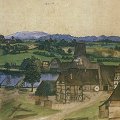 Get
Get  a high-quality picture of
Wire-Drawing Mill for your computer or notebook. ‣
Along with Saint John's Church, this is among Durer's earliest
watercolours, dating either from 1489 or 1494. Inscribed "wire-drawing
mill", it depicts a workshop which manufactured copper wire.
a high-quality picture of
Wire-Drawing Mill for your computer or notebook. ‣
Along with Saint John's Church, this is among Durer's earliest
watercolours, dating either from 1489 or 1494. Inscribed "wire-drawing
mill", it depicts a workshop which manufactured copper wire.
From a raised vantage point, our gaze passes over the large and small mills in the meadows on the banks of the River Pegnitz belonging to the city of Nuremberg. The buildings in the foreground are the Grossweiden Mill on the north bank of the River Pegnitz, near St John's Church. A mill wheel leans against one of the buildings. On the far side of the river is the Kleinweiden Mill. Beyond this are villages lying on the outskirts of Nuremberg and the mountains. Durer has again lavished great care on some of the details, such as the distant houses. His colouring is reminiscent of Netherlandish landscapes, with brown tones in the foreground, greens in the middle ground and bluish mountains in the distance.
Although the detailed composition of the sheet still accords with Late Medieval workshop tradition, the fine glazes, produced with considerably thinned watercolours, already herald the freer brushstrokes of later watercolours. In this respect the sheet can be called a milestone in Durer's development of the technique of watercolour painting.
The Courtyard of the Castle in Innsbruck with Clouds (1494)
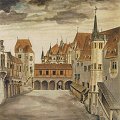 Get
Get  a high-quality picture of
The Courtyard of the Castle in Innsbruck with Clouds for your computer or notebook. ‣
The picture shows a second variation of the castle courtyard in the
Tirol, with clouds. The courtyard of the Gothic building is seen from a
different side than in the first view. Here Durer chose the balcony in the
gate tower as his viewpoint, while in the first sheet a window in the
opposite transverse wing was his starting point. There is still some
uncertainty in his application of perspective here. However, the variety
of forms of the Late Gothic buildings are recorded in detail.
a high-quality picture of
The Courtyard of the Castle in Innsbruck with Clouds for your computer or notebook. ‣
The picture shows a second variation of the castle courtyard in the
Tirol, with clouds. The courtyard of the Gothic building is seen from a
different side than in the first view. Here Durer chose the balcony in the
gate tower as his viewpoint, while in the first sheet a window in the
opposite transverse wing was his starting point. There is still some
uncertainty in his application of perspective here. However, the variety
of forms of the Late Gothic buildings are recorded in detail.
The Courtyard of the Castle in Innsbruck without Clouds (1494)
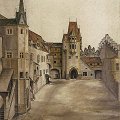 Get
Get  a high-quality picture of
The Courtyard of the Castle in Innsbruck without Clouds for your computer or notebook. ‣
This watercolour, together with another view of a castle courtyard in
the Tirol, was presumably created during Durer's first Italian journey in
about 1494. The location of the castle is still disputed. Together with
the other sheet, we have two differing views of the same castle courtyard.
They show an extended courtyard with various Gothic castle buildings
grouped around it. The bay-like staircase on the left is at its front side
opposite the gate tower from which the second view of the courtyard was
produced.
a high-quality picture of
The Courtyard of the Castle in Innsbruck without Clouds for your computer or notebook. ‣
This watercolour, together with another view of a castle courtyard in
the Tirol, was presumably created during Durer's first Italian journey in
about 1494. The location of the castle is still disputed. Together with
the other sheet, we have two differing views of the same castle courtyard.
They show an extended courtyard with various Gothic castle buildings
grouped around it. The bay-like staircase on the left is at its front side
opposite the gate tower from which the second view of the courtyard was
produced.
Pond in the Woods (1496)
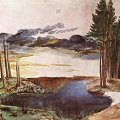 Get
Get  a high-quality picture of
Pond in the Woods for your computer or notebook. ‣
Dating from the same period as House by a Pond, this powerfully
coloured watercolour depicts pine trees around a pond or lake, probably in
the sandy heathland near Nuremberg. Although the tufts of grass in the
foreground are rendered with painstaking detail, other parts of the
picture have been left unfinished, particularly the sky and the greenery of
the trees on the left. The water seems to stretch out far into the
distance, changing colour from deep blue to a browny colour which reflects
the evening sun. The powerful atmosphere is a vision of primeval nature.
a high-quality picture of
Pond in the Woods for your computer or notebook. ‣
Dating from the same period as House by a Pond, this powerfully
coloured watercolour depicts pine trees around a pond or lake, probably in
the sandy heathland near Nuremberg. Although the tufts of grass in the
foreground are rendered with painstaking detail, other parts of the
picture have been left unfinished, particularly the sky and the greenery of
the trees on the left. The water seems to stretch out far into the
distance, changing colour from deep blue to a browny colour which reflects
the evening sun. The powerful atmosphere is a vision of primeval nature.
A sketch, hidden for centuries, was recently discovered on the reverse of this work. It had been stuck into an album of drawings in 1637, which in 1753 was presented by Sir Hans Sloane to the newly-established British Museum. It was only in 1970 that the watercolour was removed from the album and the sketch was found on the reverse. Although Durer seems to have abandoned this very rough sketch at an early stage, it appears to depict a similar evening sky to the one in the final watercolour.
Young Hare (1502)
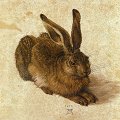 Get
Get  a high-quality picture of
Young Hare for your computer or notebook. ‣
Durer was one of the earliest artists to tackle nature studies and this
is one of his finest examples. The frightened hare has cowered down with
its ears alert, ready to spring up and flee. Durer probably painted the
hare from both a stuffed model and very careful observation of live
animals.
a high-quality picture of
Young Hare for your computer or notebook. ‣
Durer was one of the earliest artists to tackle nature studies and this
is one of his finest examples. The frightened hare has cowered down with
its ears alert, ready to spring up and flee. Durer probably painted the
hare from both a stuffed model and very careful observation of live
animals.
The famous watercolour became very popular and, together with the Praying Hands and Piece of Turf, has been reproduced on a massive scale in the twentieth century. The important new feature of this study is the lifelike depiction of the animal. The hare's fur is depicted in delicate gradations and shades with a variety of brushstrokes. The mullion and transom of a window are reflected in its shining eye - the mirror of the soul. Durer's ability to give an animal portrait such an individual expression presumably contributed to the considerable imitation of the work.
The Young Hare was first painted in watercolour. Durer then applied some opaque gouache on top of the watercolour, painting groups of lines which are longer or shorter, thicker or finer, depending on how the fur lies on the animal's body. Finally, he added the white highlights. The shadow helps to give the animal a three-dimensional appearance. Durer added his monogram and the year in a prominent position, to show that he regarded it as a finished work of art.
The Large Turf (1503)
 Get
Get  a high-quality picture of
The Large Turf for your computer or notebook. ‣
Unlike the extremely sylized depictions of flowers in the Middle Ages,
Durer's Large Turf already reflects a considerable degree of empiricism:
all botanical details are rendered with an almost microscopic precision,
and Durer tried to give the impression that this partial view was totally
accidental by showing a chaotic arrangement of grasses, leaves and meadow
flowers. The plants that have been identified are daisies, yarrow,
plantains, dandelions, pimpernels and cocksfoot. Symbolic aspects are not
likely to be involved here. Durer was probably more interested in the
medicinal and herbal aspects, as well as the healing powers, of different
kinds of sap.
a high-quality picture of
The Large Turf for your computer or notebook. ‣
Unlike the extremely sylized depictions of flowers in the Middle Ages,
Durer's Large Turf already reflects a considerable degree of empiricism:
all botanical details are rendered with an almost microscopic precision,
and Durer tried to give the impression that this partial view was totally
accidental by showing a chaotic arrangement of grasses, leaves and meadow
flowers. The plants that have been identified are daisies, yarrow,
plantains, dandelions, pimpernels and cocksfoot. Symbolic aspects are not
likely to be involved here. Durer was probably more interested in the
medicinal and herbal aspects, as well as the healing powers, of different
kinds of sap.
Although a careful examination reveals the different species, one is left with the effect of the whole of a section of turf, rather than the individual plants. Durer painted another work known as The Small Turf (Graphische Sammlung Albertina, Vienna) and hence the name of the present watercolour.
Albrecht Durer Art

|
|
More
Articles
 Art Encyclopedia A world history of art in articles.
Art Encyclopedia A world history of art in articles.
Renaissance
Albrecht Durer
Altar paintings.
Portraits.
Life and work.
Art
 Art Wallpapers Art image collections for your desktop.
Art Wallpapers Art image collections for your desktop.
Della Francesca Art, $19
(95 pictures)
Da Vinci Art, $25
(80 pictures)
Michelangelo Art, $29
(180 pictures)
Raphael Art, $25
(125 pictures)
Titian Art, $29
(175 pictures)
Durer Art, $25
(120 pictures)
